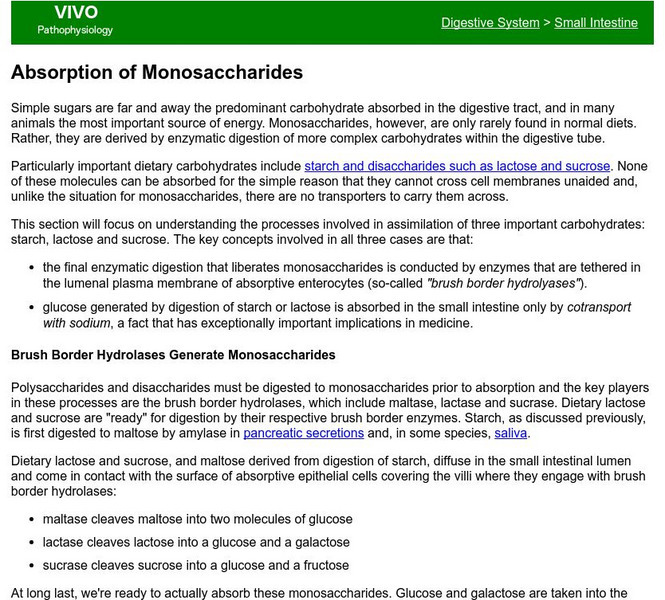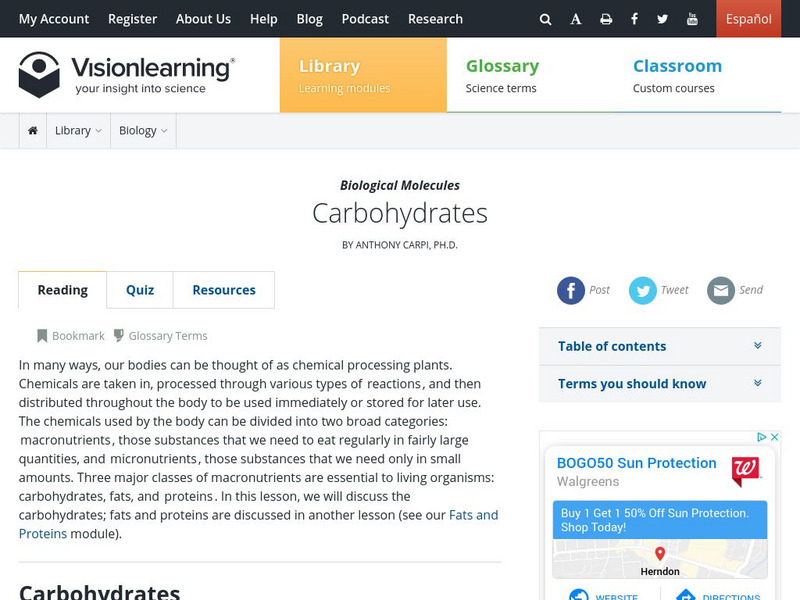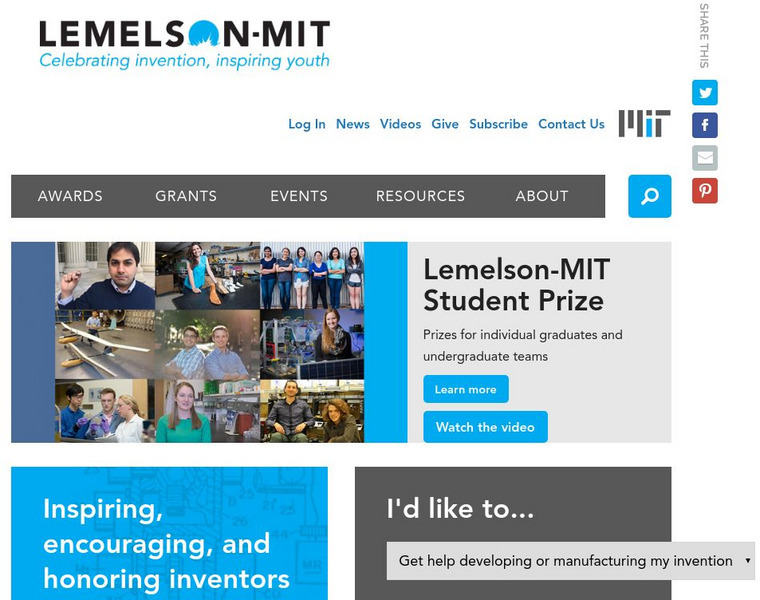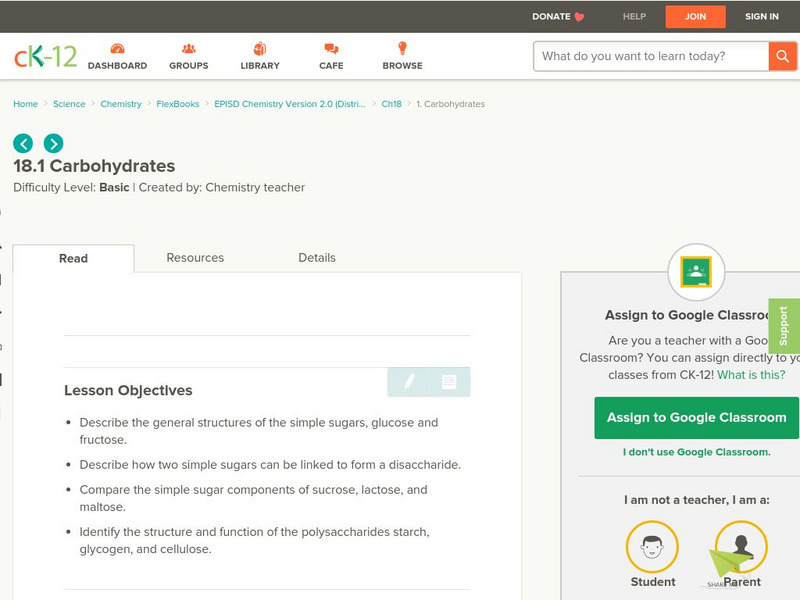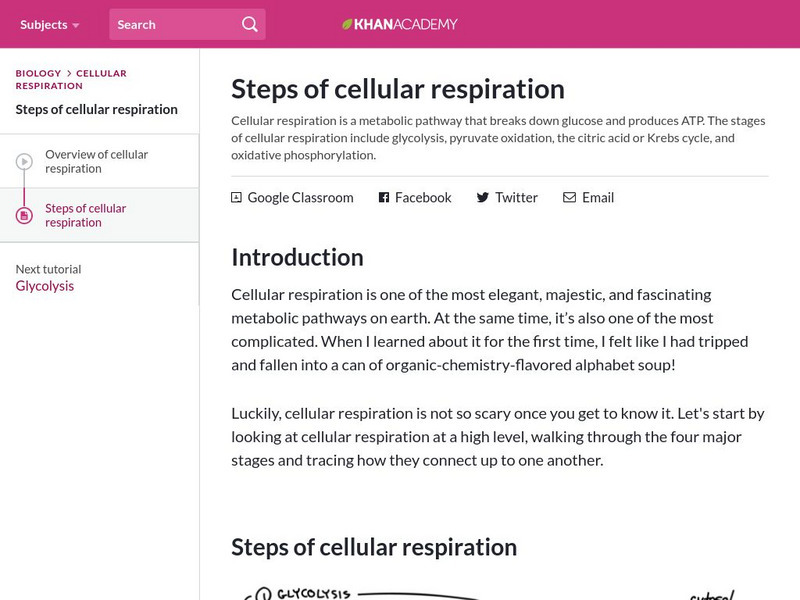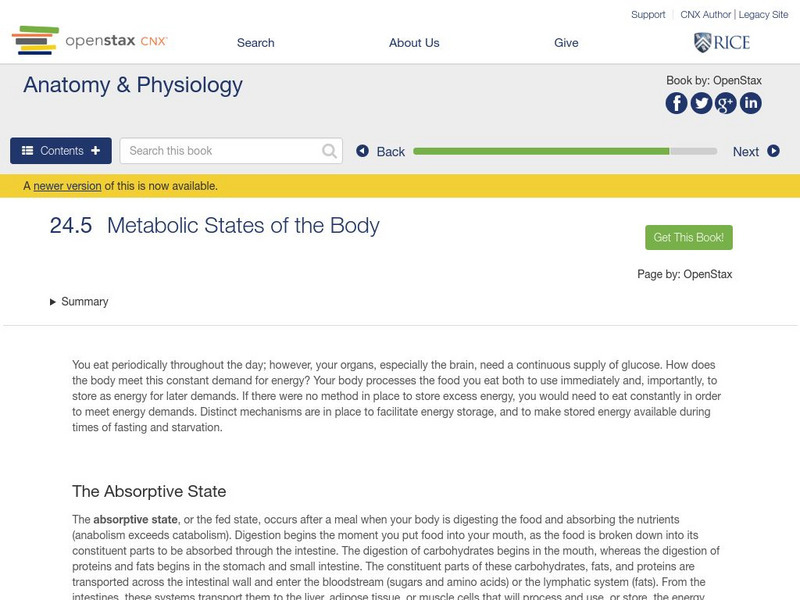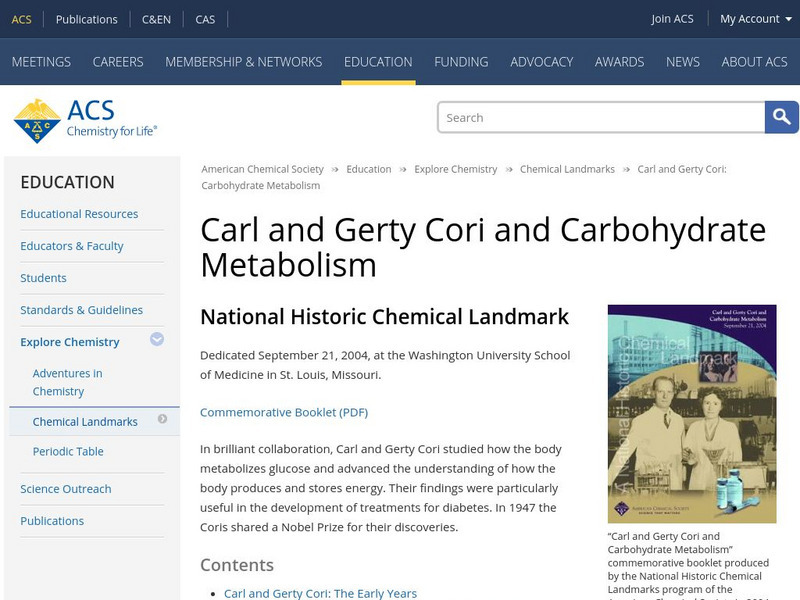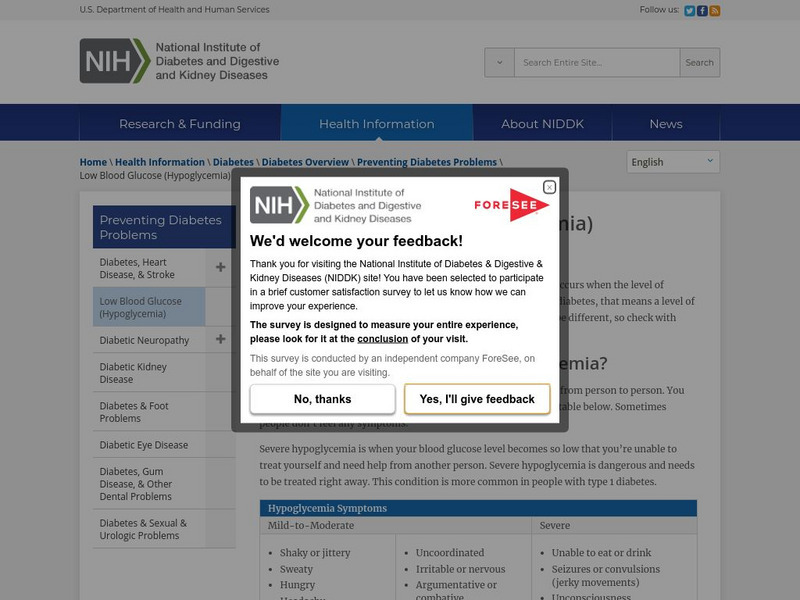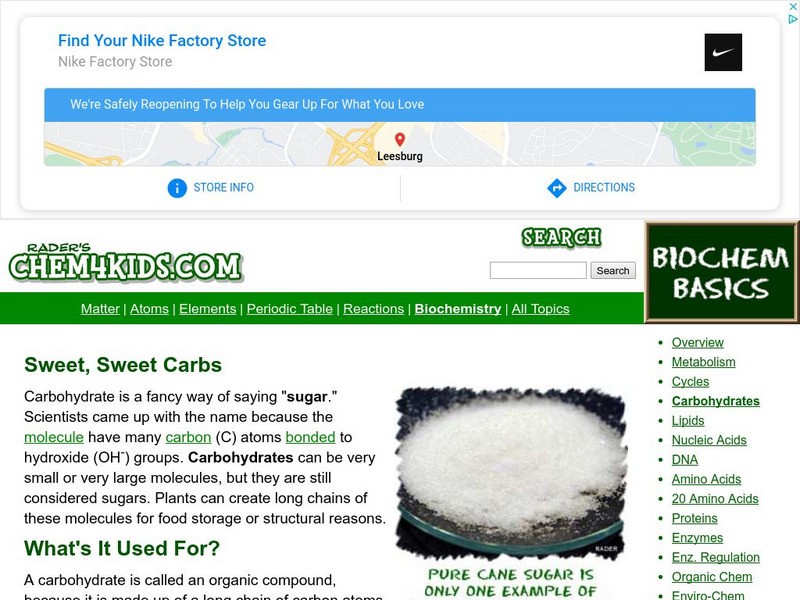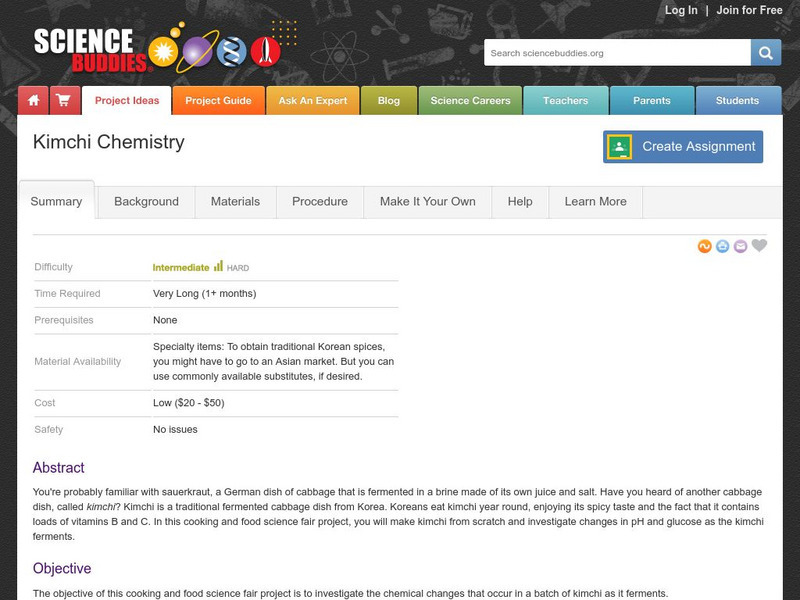Science Buddies
Science Buddies: Study Chirality With a Homemade Polarimeter
Some molecules can be either left- or right-"handed." The left- and right-handed molecules have the same number and type of atoms, and their chemical structures look identical, but they are actually mirror images of each other. Many...
Science Buddies
Science Buddies: How Sweet It Is! Measuring Glucose in Your Food
You know that sugar makes food sweet. But did you know that there are different kinds of sugar? Sucrose is the granulated sugar that you usually use for baking. Another kind of sugar, which is found in honey and in many fruits, is...
Estrella Mountain Community College
On Line Biology Book: Photosynthesis
A comprehensive delve into the many facets of photosynthesis. Text is supplemented with effective pictures and graphs. Review questions can be found at the end of the site.
Colorado State University
Colorado State University: Absorption of Monosaccharides
Page focuses on the processes involved in the generation of monosaccharides and their absorption into the digestive tract. Image shows the transport of glucose across the intestinal epithelium.
Vision Learning
Visionlearning: Biological Molecules: Carbohydrates
An explanation of why carbohydrates are important nutrients for the human body. Chemical formulas and structures are used to demonstrate simple and complex carbohydrates.
WebMD
Medicine Net: Hypoglycemia
MedicineNet.com provides a very detailed article on hypoglycemia, its symptoms, causes, diagnosis, and treatments.
University of Hamburg
University of Hamburg: Chloroplasts and Other Plastids
This site provides detailed information on chloroplasts. Explains the many duties that chloroplasts perform and why they are so important. Good diagrams.
Massachusetts Institute of Technology
Mit: Inventor of the Week: Helen Murray Free
Biography of Helen Free, detailing her life as a chemist and inventor who developed many products for consumer use, including a convenient at-home glocose level test.
CK-12 Foundation
Ck 12: Carbohydrates
[Free Registration/Login may be required to access all resource tools.] Students investigate the general structures of the simple sugars, glucose and fructose, and find out how two simple sugars can be linked to form a disaccharide. They...
Mayo Clinic
Mayo Clinic: Video: How Diabetes Affects Your Blood Sugar
Learn about the disease diabetes and how it affects blood sugar in affected people, in this Mayo Clinic animated video. [2:10]
WebMD
Web Md: Hypoglycemia and Diabetes
This page from WebMD Health presents good, comprehensive information on a problem common to all diabetics at some time - low blood sugar (hypoglycemia). Discusses the symptoms, hypoglycemia in diabetes and how to manage hypoglycemia in...
Khan Academy
Khan Academy: Steps of Cellular Respiration
Resource walks you through the four major stages of cellular respiration which include glycolysis, pyruvate oxidation, the citric acid or Krebs cycle, and oxidative phosphorylation and traces how they connect up to one another.
Khan Academy
Khan Academy: Glycolysis
Provides an overview of glycolysis which is the first step in the breakdown of glucose to extract energy for cellular metabolism. The article discusses in detail its two main phases: the energy-requiring phase and the energy-releasing...
OpenStax
Open Stax: Anatomy & Physiology: Metabolic States of the Body
Students describe what defines each of the three metabolic states of the human body: the absorptive state, the postabsorptive state, and starvation.
American Chemical Society
American Chemical Society: Carl and Gerty Cori and Carbohydrate Metabolism
Profiles of Carl and Gerty Corbi, American biochemists who studied how the human body metabolizes glucose. Their research advanced treatments for diabetes, and won them a Nobel Prize in 1947. Includes links to additional resources.
National Institutes of Health
Niddk: Low Blood Glucose/hypoglycemia
This resouce discusses what hypoglycemia is, its symptoms, causes and treatments.
Chem4kids
Chem4 Kids: Sweet Sweet Carbs
Here you can learn all about carbohydrates! Content explores what carbohydrates are used for in the body, as well as the different types: saccharides, regular sugars, and polysaccharides.
CK-12 Foundation
Ck 12: Life Science: Organic Compounds
[Free Registration/Login may be required to access all resource tools.] The main chemical components of living organisms are known as organic compounds and are built around the element carbon. Living things are made up of very large...
Science Buddies
Science Buddies: Project Ideas: Kimchi Chemistry
In this cooking and food science fair project, the student will make a batch of kimchi, the national dish of Korea, and investigate the changes in pH and glucose concentration as it ferments. The Science Buddies project ideas are set up...
Other
Joslin Diabetes Center: Diabetes Beginner's Guide
Get the basic facts about diabetes from this resource. Includes information about how diabetes is diagnosed, what the treatment involves, who usually gets diabetes, the different types of the disease, and much more.
Aetna Intelihealth
Aetna: Inteli Health: Diabetes Type 2 Faq
Thorough overview of type 2 diabetes through a Q & A format. Use this site to learn about symptoms, prevention, treatment, and more.
PBS
Pbs: Scientific American Frontiers: Teaching Guide: Tasty Models (5 8)
With this lesson, students create models of carbohydrates and proteins using pieces of candy in order "to visualize the atomic arrangements of nutrient molecules."
Vision Learning
Visionlearning: Food Chemistry: Carbohydrates
Read about carbohydrates, which make up one of the three "Major classes of macronutrients that are essential to living organisms." In addition to defining several terms, including carbohydrate, simple sugars, complex carbohydrates,...
Ohio State University
Ohio State University: Lipids and Carbohydrates
An introduction to these chemical families. Diagrams are easy to understand and the text explains basic concepts well.





